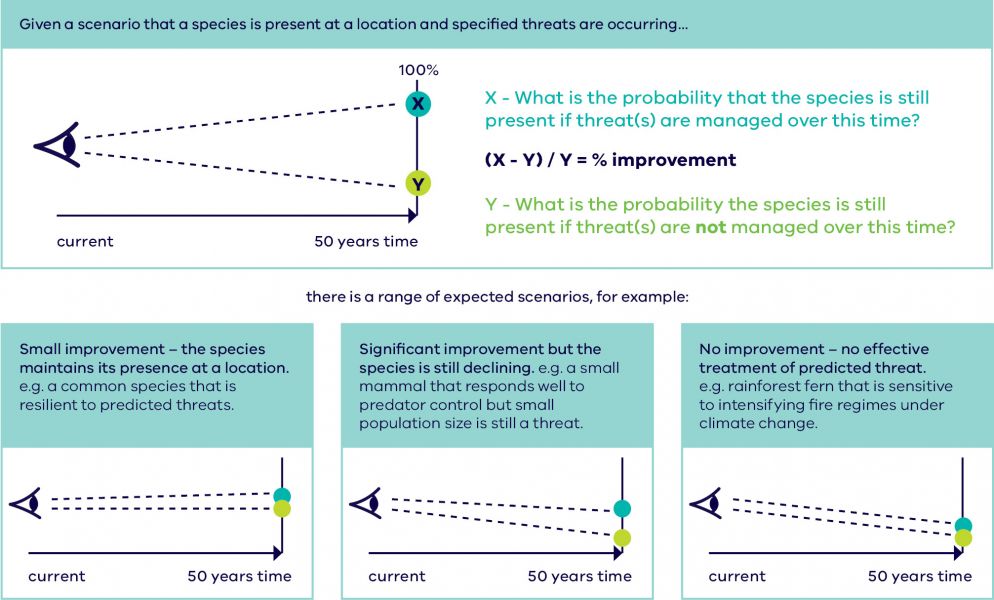Strategic Management Prospects (SMP) was developed by the Victorian government as a long-term, strategic approach to identifying cost-effective management actions that deliver an improved outlook for as many species as possible across Victoria.
What data goes into SMP?
The inputs to SMP are fine-scale, state-wide spatial models based on extrapolation from primary datasets. The models integrate information on the likely presence of threats and the costs and benefits of management actions to identify the most cost-effective actions across Victoria.
SMP contains habitat distribution models, threat models, cost models and expert-elicited benefit models for over 4,000 species of vertebrate animals and vascular plants and for over 20 management actions that address threats to Victoria’s biodiversity.
Further reading
Strategic Management Prospects overview and approach (PDF, 492.4 KB)
Strategic Management Prospects overview and approach (DOCX, 258.1 KB)
Habitat Distribution Models
Habitat Distribution Models predict and map where species are most likely to occur, and also where they might not occur, using the best scientific information we have available.
SMP in NatureKit contains Habitat Distribution Models for around 4,200 species.
Habitat Distribution Models are developed from species sightings and observation data reported to the Victorian Biodiversity Atlas.
For more information on viewing and downloading the models, visit Habitat distribution models (HDMs).

Further reading
Habitat Distribution Models and Habitat Importance Models (PDF, 446.4 KB)
Habitat Distribution Models and Habitat Importance Models (DOCX, 864.5 KB)
Threat models
Threat models take into account the known distribution of threats to biodiversity (e.g. foxes, weeds) and the characteristics of the environment (e.g. terrain, climate) to generate maps that show where a threat is likely to be present across Victoria.
Threat models in SMP focus on the broad, common threats for which we can generate robust, state-wide spatial models, such as weeds, pest predators and pest herbivores.
Benefit of action models
Benefit of action models in SMP are estimates of the likely future of biodiversity values under different management regimes, over a time horizon of 50 years.
What do we mean by ‘benefit’?
In SMP, ‘benefit’ is measured as Change in Suitable Habitat (CSH), a standardised metric developed for Biodiversity 2037. ‘Suitable habitat’ includes the type, extent and configuration of habitat for a species, and the factors that influence how well much a species can make use of the habitat.
Change in Suitable Habitat is the increase in likelihood that a species will persist at a location in 50 years time, in response to sustained management of relevant threats. The benefit models in SMP are based on the overall CSH for all species at a location. CSH for individual species is available in the Summary Area reports.

Figure: Expert elicitation to estimate the likelihood of species persistence
How we estimate benefit
Benefit models are developed using the best-practice scientific method of expert elicitation. Experts are asked to estimate the probability that a species will be present in a location in the future if threat/s are managed, and the probability of species persistence if threat/s are not managed.
The opinions of over 100 experts from universities, government and non-government organisations are collected and analysed to develop benefit models for each action or combination of actions that address specific threats to biodiversity.
Expert opinions on site-specific and situation-specific settings are extrapolated using Habitat Distribution Models and other variables, to the state-wide scale required for SMP.
Further reading
Technical Background for decision support measures and tools in Biodiversity 2037 (PDF, 92.2KB)
Cost models
Cost models are estimates of the likely costs of on-ground management actions in a location, calculated in Australian dollars (AUD) per hectare, per year, over a time period of 50 years.
Cost estimates are informed by scientific and grey literature, as well as interviews with land managers and partner agencies. Cost estimates consider a range of factors including location, time and timing of the management action, opportunity costs to private landholders, transaction costs, and the cost of travelling to sites.
Note the cost models in SMP have been developed to allow standardised comparisons of the relative cost-effectiveness of actions. Real project costs may vary significantly.
Benefit-cost models
Benefit-cost models utilise cost models and expert-elicited benefit models to calculate and rank the cost-effectiveness of actions for improving the future outlook of species. Threatened species are given higher weightings in the model to reflect their greater relative importance to overall biodiversity.
Benefit-cost models help us focus on making the biggest difference possible with the resources we have to protect our threatened species and all of nature.
Further reading
Strategic Management Prospects inputs (PDF, 770.5 KB)
Strategic Management Prospects inputs (DOCX, 927.9 KB)
Using models consciously
Models are a central component of modern science that help us make sense of complex calculations and datasets.
Spatial mapping of environmental data always requires some form of extrapolation. Usually this is done by mathematical modelling where the logic and method are clear and easily repeatable, and any comparisons across values (e.g. species habitats) can be consistently made.
All spatial models have some limitations and inaccuracies. Good modelling practice allows insights into the limitations of inputs and outputs, to enable users to be aware of how reliable the mapping is.
The models in SMP are reviewed and updated regularly to incorporate new data and species records, and advances in conservation knowledge and land management.
Addressing knowledge gaps
Visit our Knowledge Framework to see how we are identifying biodiversity knowledge gaps to better invest in research, monitoring and data collection.
SMP is updated regularly as new research, data and modelling methods become available. Future versions of SMP will include freshwater and marine environments.
How to provide data and feedback
To contribute data that will inform future SMP updates, submit your species observations to the Victorian Biodiversity Atlas.
Help us improve the SMP user experience by sharing your feedback. Let us know if you need support with using NatureKit, or if the SMP models show something different to your lived experience of a landscape.
Publications
Thomson, J., Regan, T., Hollings, T., Amos, N., Geary, W., Parkes, D., Hauser, C., White M. (2020) Spatial conservation action planning in heterogeneous landscapes
Geary, W., Buchan, A., Allen, T., Attard, D., Bruce, M., Collins, L., Ecker, T., Fairman, T., Hollings, T., Loeffler, E., Muscatello, A. (2021) Responding to the biodiversity impacts of a megafire: A case study from south-eastern Australia’s Black Summer
More Information
SMP forms part of the Biodiversity Spatial Data Foundation. For help or further information get in touch at biodiversity.info@deeca.vic.gov.au.
Page last updated: 08/08/25